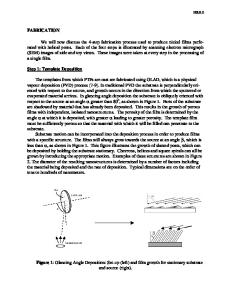Fabrication, characterization and chemical modification of anthracene based nanostructures
- PDF / 665,998 Bytes
- 8 Pages / 585 x 783 pts Page_size
- 59 Downloads / 363 Views
Ranjana Mehrotraa) and H.C. Kandpal Optical Radiation Standards, National Physical Laboratory, New Delhi 110012, India (Received 6 November 2006; accepted 20 February 2007)
Anthracene based nano/microstructures of different sizes and shapes like tubes/fibers are synthesized using a simple open air chemical vapor deposition technique. Thermal solid phase reaction between anthracene 9-carboxylic acid and calcium oxide reported recently [H. Liu et al., J. Am. Chem. Soc. 125, 10794 (2003)] is used to obtain organic molecular nanostructures. The products of temperature (320 °C) induced reaction get deposited on the substrates placed inside the reaction chamber as well as on the inner walls in different nano/micrometer forms, tubes/rods/fibers and having different sizes. Structural characterization of the reaction products is performed using optical microscopy, field emission electron microscopy (FE-SEM) and transmission electron microscopy (TEM). Chemical composition studies are conducted using infrared (IR), nuclear magnetic resonance (NMR), and gas chromatography (GC)-Mass spectroscopy, as well as elemental analysis. IR studies of the nanostructures obtained on the substrate using IR spectroscopy reveal the presence of C⳱O groups, the confirmatory evidence of which is obtained using energy dispersive x-ray spectroscopic (EDS) analysis. Interaction study of the C⳱O groups with ammonia vapor is conducted and resulting changes are monitored using Fourier transform infrared (FTIR). A strong covalent modification of anthracene based structures by exposure to ammonia molecules is indicated.
I. INTRODUCTION
Fabrication and characterization of one-dimensional (1D) nanostructures such as nanowires, nanorods, nanoneedles, and nanofibers are subject of increasing interest due to potential uses of such nanostructures in future nanoelectronic systems and optical nanodevices.2,3 Developing newer methods for obtaining 1D1,4–7 nanostructures and investigating their properties is an energized area of research. Synthesis of nanostructures based on ∏-conjugated organic molecules in particular has captured the attention of researchers in recent years. These nanomaterials are known to possess outstanding conducting, superconducting, optical, and spectral properties.8 Fabrication of small molecular wires or rods of these ∏-conjugated systems using innovative methods is an active area of research for nano-optoelectronic applications. Particularly linear polyacene families of organic molecules like anthracene are gaining interest9 because of their high a)
Address all correspondence to this author. e-mail: [email protected] DOI: 10.1557/JMR.2007.0369 J. Mater. Res., Vol. 22, No. 10, Oct 2007
http://journals.cambridge.org
Downloaded: 14 Mar 2015
charge mobility.9,10 Anthracene based nanostructures may be envisaged as promising materials for various technological applications. Not only that their novel, convenient, economical, and application oriented methods are always desired but the deep understanding of their chemical co
Data Loading...










